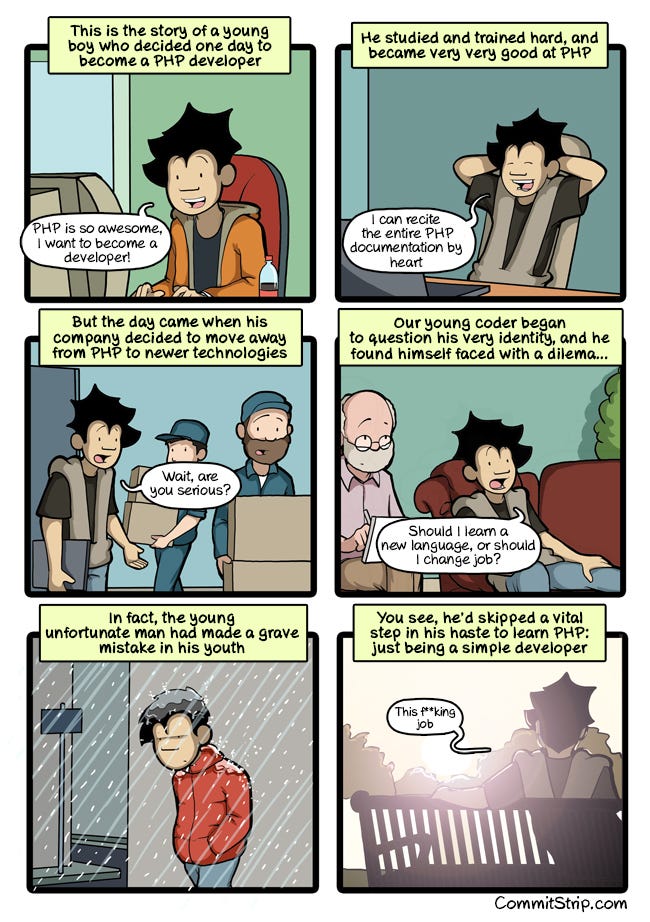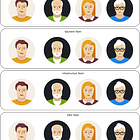T-Shaped Team Players
What the Market Needs Now!
Before starting this article, I would like to extend my thanks for reading, and also my apologies to for not being able to write last week. It was a busy but enriching week at some training where I actually learned quite a few things, I will share them here soon so stay tuned.
I will today release this short article, and expect a longer one towards the end of this week.
Have you ever encountered professionals who seem to place importance only on a certain type of knowledge? It's a situation humorously depicted in this comic strip from Commit Strip.

While expertise is certainly beneficial, it's not always a necessity in the market. In the end, we need to ask ourselves the question if we are either “problem solvers” or “executing monkeys”.
The role of engineering professionals is evolving, moving from a sole focus on knowledge to an all-encompassing approach, represented by the “T-shaped” model. The objective is not just to build right, but to build what's necessary. This calls for a blend of product, technical, and interpersonal skills. For leaders, this translates into promoting continuous learning, cross-functional teamwork, and advocating for stepping beyond comfort zones, thereby cultivating a culture that appreciates all facets of everyday work.
T-Shape: A Blend of Breadth and Depth
The T-shaped model is the idea that everyone should possess a depth of vertical expertise in their preferred area (the vertical bar of the “T”) while also having a broad horizontal understanding of ancillary areas (the horizontal bar of the “T”). This dual focus ensures not only the capability to execute specific tasks but also the ability to see beyond and understand the larger context, ensuring that what is built is truly what is needed and also not selling snake oil.
Vertical Expertise: The Depth
The vertical bar of the “T” serves as a symbol for an individual's core skill set, demonstrating their domain of deep expertise. It is their specialty, the area where they could be considered an expert or a specialist. This deep expertise is what most people have traditionally concentrated on in their day-to-day professional lives. It's the strength that they bring to the table in their field and what they are known for.
Horizontal Skills: The Breadth
The horizontal bar symbolizes the broad range of complementary skills outside of one's core expertise. This notably includes:
Product Sense: An understanding of the product's goals, target users, and market position. This involves empathy towards the user's needs, an appreciation of user experience (UX) principles, and the ability to prioritize features based on user and business value.
Collaboration and Communication: The ability to work effectively with cross-functional teams, including product managers, designers, and other stakeholders. Clear communication of technical difficulties, solutions, and trade-offs in a way that is accessible to non-technical team members is vital.
Business Acumen: A grasp of the business context in which the product operates. This includes understanding the competitive landscape, business models, and how one's work contributes to the overall success and strategy of the company.
Adaptability and Learning: The capacity to quickly learn new skills, adapt to new tools, technologies, and methodologies as required by the ever-changing tech landscape.
Any & All Technical Knowledge: refers to a wide range of technical skills and understanding that one might need to do their job effectively. It emphasizes the need for individuals to be comfortable with various technologies and able to learn and adapt to new technical tools and methodologies as required.
Benefits of becoming T-Shaped
Here are the benefits of becoming T-shaped:
Personal Growth: The T-shaped model encourages continuous learning and adaptation, leading to personal and professional development.
Enhanced Job Satisfaction: Having a broader understanding of the product and the business can make the work more meaningful and satisfying.
Increased Marketability: With a diverse set of skills, T-shaped people are more attractive to employers in a competitive job market.
Job Security: The ability to adapt to new technologies and methodologies also provides more job security in a rapidly changing industry.
Rounding Up
As you may have noticed, I am not naming development anywhere. T-shaped has already crossed that line, it's not only applicable to technical roles but also to business roles. Where, for example, to take decisions is not only valid anymore to not understand certain parts of the product.
In conclusion, T-shaped embodies the holistic skill set essential in today's dynamic product development environments. By fostering these all-rounded professionals, engineering leaders can ensure their teams are not just executing to spec but actively contributing to the creation of meaningful, impactful products. As we progress into increasingly complex and user-centric markets, the T-shaped approach will undoubtedly become not just beneficial, but essential for success.
🗞️ Related Articles
📚 Picks of the Week
Understanding Data Pipelines: Why The Heck Businesses Need Them by Yordan Ivanov
Perceived Difficulty is a Productivity Killer: How to Build Focus by Raviraj Achar
·✌️ That’s all folks
I love hearing from readers, and I’m looking for feedback. How am I doing with Leads Horizons? Is there anything you’d like to see more or less? Which aspects of the newsletter do you enjoy the most?
Use the links below, or even better, hit reply and say hello. I’d love to hear from you!
Please don't hesitate to connect with me on LinkedIn and send a message. I always respond to every one!




Hi Alvaro, I've gently massaged the T-shaped skill paradigm to SREs for some time now, perhaps 3 years. Lots of arms going up in the air. Are you finding the same reluctance among devs?
T-his article serves as a good introduction for everyone who is not familiar with the T-shape concept.
T-hanks for including Perspectiveship in your weekly picks.